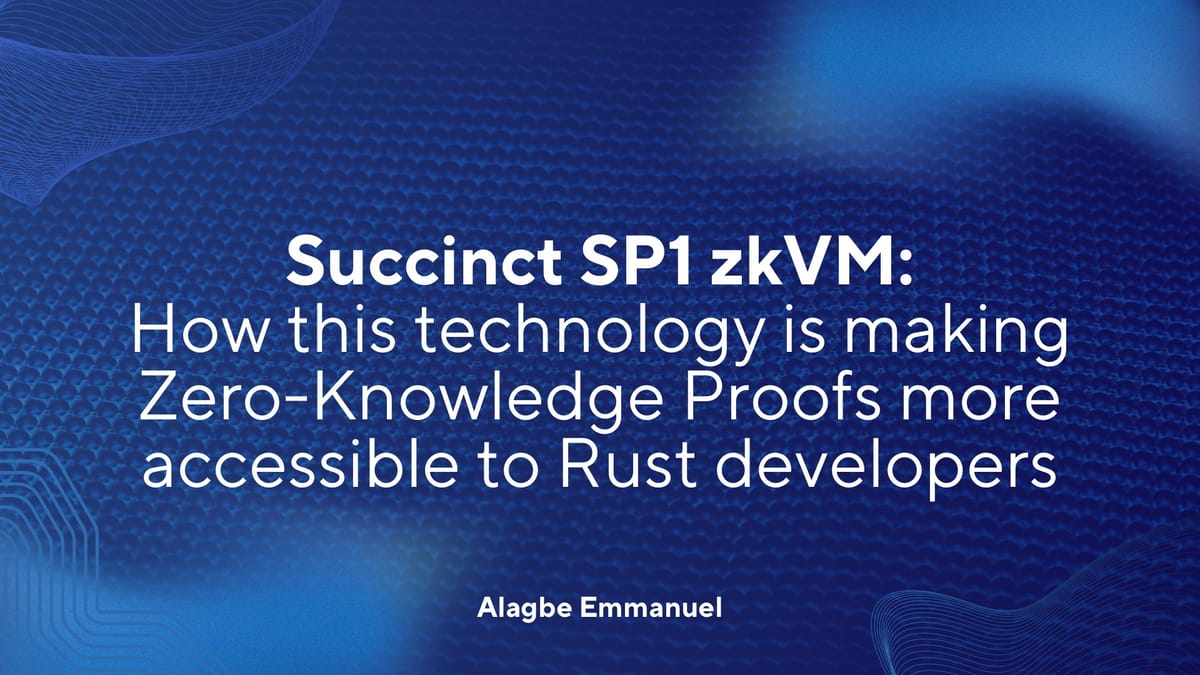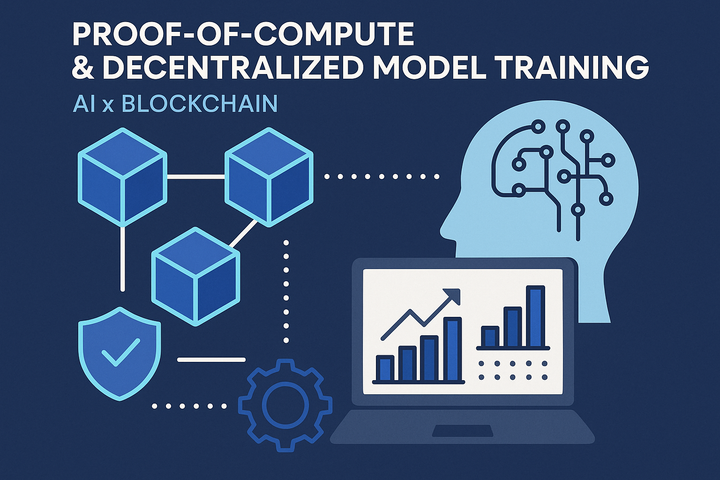Succinct SP1 zkVM: How this technology is making Zero-Knowledge Proofs more accessible to Rust developers

Introduction
Zero-Knowledge Proofs (ZKPs) have emerged as a game-changer in blockchain, offering enhanced privacy, scalability, and trustless computation. But for years, their steep learning curve has kept them out of reach for most developers. Enter Succinct Processor 1 (SP1), a zkVM built by Succinct Labs, designed to bridge that gap. By integrating seamlessly with Rust, SP1 brings the power of ZKPs to a broader audience, combining high performance with developer-friendly tools and open-source flexibility. In this article, we’ll explore how SP1 is unlocking a new era of verifiable applications for everyday Rust developers.
What Is SP1 zkVM?
SP1 zkVM is a zero-knowledge virtual machine built by Succinct, designed to run general-purpose Rust code and produce efficient zero-knowledge proofs. It operates on the principle that developers shouldn’t need to master obscure DSLs or deep cryptographic concepts to leverage ZKPs. Instead, they can write familiar Rust code, compile it, and generate proofs of correct execution.
The Power of Zero-Knowledge Proofs
ZKPs allow a prover to demonstrate that a computation is correct without revealing sensitive data. This capability underpins critical blockchain use cases:
- Privacy: Enabling confidential transactions or ZK-based identity systems.
- Scalability: Powering ZK Rollups to compress thousands of transactions into a single proof.
- Trustless Interoperability: Verifying cross-chain data securely for bridges and oracles.
- Security: Replacing trust assumptions with cryptographic guarantees.
Historically, ZKP development required deep cryptographic knowledge, bespoke circuits, and years of effort, making it inaccessible to most developers. SP1 dismantles these barriers, bringing ZKPs within the reach of Rust developers.
How SP1 Bridges the Gap
SP1 provides a radically different developer experience by embracing three core principles:
1. Write Once, Prove Anywhere
You can write standard Rust code, compile it for SP1, and prove its execution across any supported proof system. This significantly lowers the mental overhead for ZK application development.
2. Use Familiar Toolchains
SP1 integrates tightly with the Rust compiler (via LLVM), enabling developers to:
- Use mature libraries and crates
- Leverage familiar testing and debugging workflows
- Avoid learning new DSLs or ZK-specific languages
3. Stay Modular and Composable
SP1 was designed for modularity. It separates the virtual machine execution from the cryptographic proof system, allowing developers to plug in different SNARKs or commit schemes. This makes SP1 future-proof and adaptable to different blockchain ecosystems.
SP1: A Game-Changer for Rust Developers
SP1 is a high-performance, open-source zkVM that verifies the execution of Rust programs (or other LLVM-compiled languages like C++ or Swift) while generating ZKPs. Fully audited by firms like Veridise and Cantina, SP1 is production-ready, securing over $1 billion in total value locked (TVL) across projects like Polygon, Celestia, and OP Succinct. Here’s how SP1 makes ZKPs accessible:
1. Rust-Powered Simplicity
SP1 lets developers write ZKP logic in standard Rust, using familiar tools, crates (e.g., revm, alloy, serde), and the Rust standard library. This eliminates the need to learn obscure ZK frameworks or design custom circuits. For instance, SP1 Reth, a proof-of-concept zkEVM, was built with just 2,000 lines of Rust code, achieving transaction proof costs as low as $0.01. Projects like OP Succinct use SP1 to transform Optimism Rollups into ZK Rollups with minimal effort, showcasing its developer-friendly approach.
By abstracting cryptographic complexity, SP1 enables Rust developers to focus on building applications, not wrestling with “moon math.”
2. Blazing-Fast Performance
SP1 delivers unmatched performance, outpacing competitors like RISC Zero by up to 28x for blockchain workloads. Key optimizations include:
- Custom Precompiles: SP1 supports precompiles for operations like
keccak256andsecp256k1, slashing RISC-V cycles by 5–10x. - Memory Efficiency: A “shared challenges” technique ensures consistent memory with minimal overhead.
- GPU Acceleration: SP1’s GPU prover offers up to 10x better speed and cost for proof generation.
- STARK-to-SNARK Wrapping: SP1 produces constant-sized proofs verifiable on EVM chains for ~275,000 gas, ensuring cost-effective on-chain verification.
These features make SP1 ideal for high-throughput applications like ZK Rollups and cross-chain bridges.
3. Seamless Tooling
SP1’s Rust SDK and CLI tools (sp1up, cargo prove) streamline the ZKP workflow:
- Compile: Transform Rust code into RISC-V ELF files.
- Prove: Generate proofs locally or via Succinct’s Prover Network for speed.
- Verify: Deploy proofs on-chain with auto-generated Solidity contracts.
This intuitive pipeline allows developers to build complex ZKP systems—like a Tendermint light client—in weeks, not years.
4. Open-Source Collaboration
SP1’s MIT-licensed codebase (github.com/succinctlabs/sp1) fosters a vibrant community. Contributors from Polygon, Celestia, and Scroll have added custom precompiles and optimizations, enhancing SP1’s capabilities. A public audit competition, yielding no critical issues, underscores its security and reliability.
5. Cross-Chain Versatility
SP1 supports a wide range of blockchain ecosystems:
- EVM Chains: Powers Polygon’s AggLayer, Celestia’s Blobstream, and OP Succinct for ZK Rollups and interoperability.
- Solana: A December 2024 verifier enables ZKPs for privacy (e.g., ZK KYC) and scalability (e.g., ZK coprocessing).
- Cosmos and Beyond: Facilitates secure cross-chain bridging.
This flexibility makes SP1 a universal ZKP tool for Rust developers.
Real-World Success
SP1 is already reshaping blockchain infrastructure:
- Polygon’s AggLayer: Uses SP1 for fast, secure cross-chain proofs.
- Celestia: Bridges data availability to Ethereum efficiently.
- Helium and Zeta Markets: Scales IoT and DeFi on Solana.
- OP Succinct: Reduces Rollup finality times and costs.
These deployments highlight SP1’s real world impact.
The Significance
This shift means more developers, especially those already proficient in Rust can join the ZK revolution without reinventing the wheel. It opens the door to faster experimentation, more secure applications, and a lower barrier to entry for open-source contributors and startups alike.
Looking Ahead
While SP1’s alpha phase had limitations, its August 2024 release marked production readiness. Future updates, like SP1-2FA (adding TEEs) and SP1 Turbo (v4.0.0), promise further improvements. Succinct Labs also aims to expand SP1’s use beyond blockchain, potentially into AI or voting systems.
Conclusion
SP1 zkVM is a breakthrough for Rust developers, making Zero-Knowledge Proofs accessible, fast, and practical. By leveraging Rust’s ecosystem, delivering stellar performance, and fostering open-source innovation, SP1 empowers developers to build secure, scalable, and private blockchain applications with ease. As SP1 evolves, it’s poised to redefine verifiable computing, proving that ZKPs are no longer the domain of specialists, they’re for every Rust developer.



Comments ()